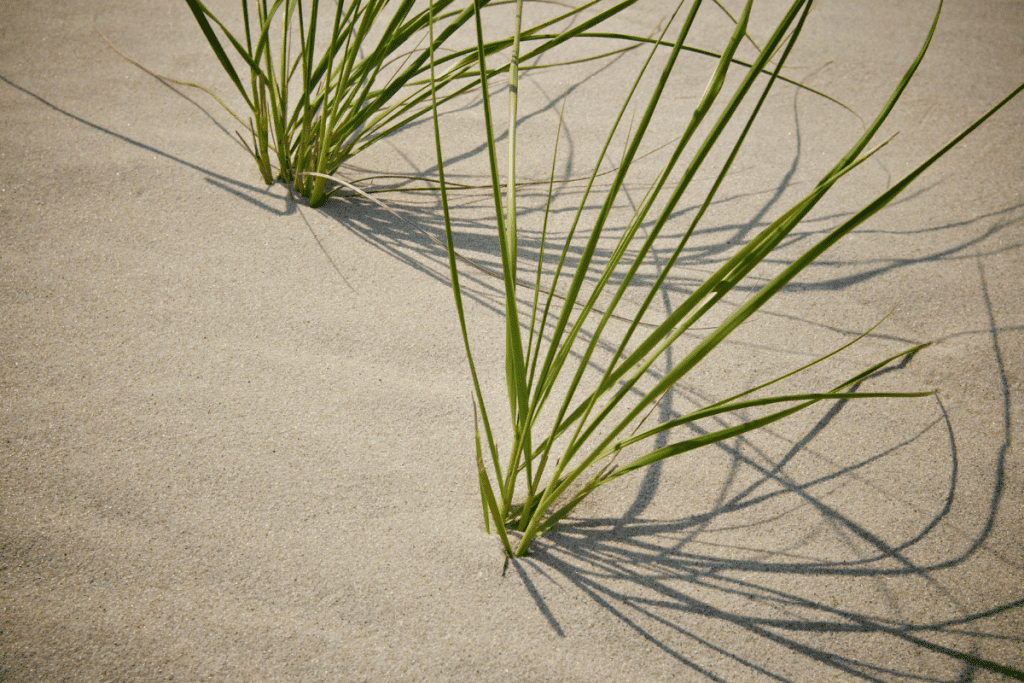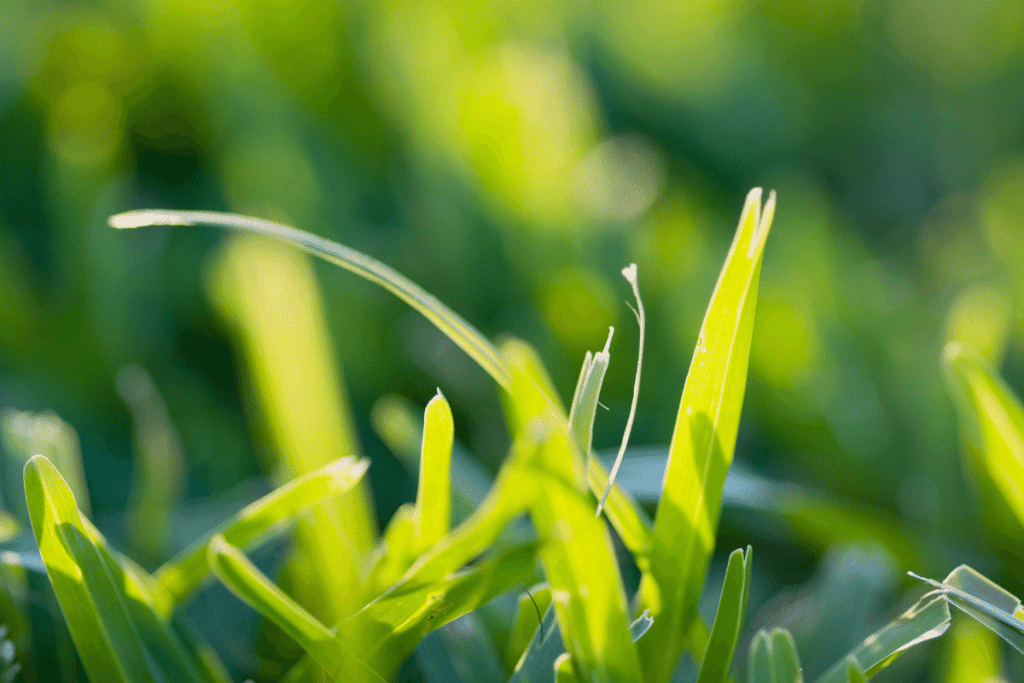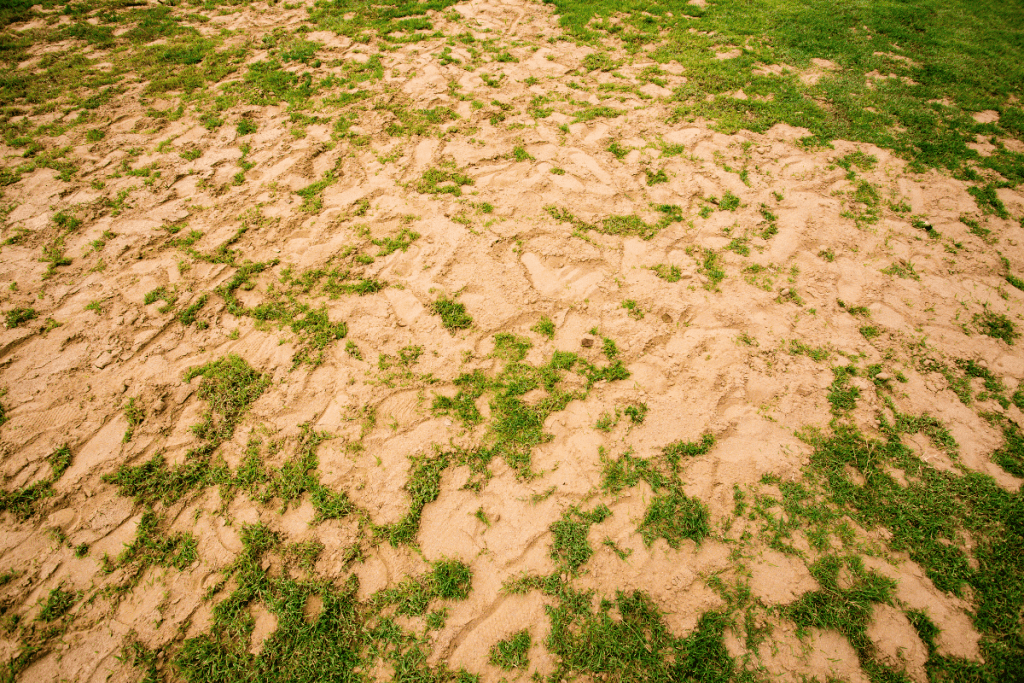Sandy soils are not only found in coastal areas; they also occur throughout a 12-State region in the central part of the United States, where they cover about 100 million acres.
As a homeowner, sandy soils present a challenging aspect if you want a beautiful yard with a green lawn because these soils are porous and do not retain water or nutrients and other types of soil.
Fortunately, several types of grass grow well in sandy soils, including both warm-season and cool-season grasses.
We have compiled a comprehensive list with information about their characteristics and how to grow them.

Table of Contents
Bahia grass
Bahia is a low-maintenance, warm-season grass with a very deep root system and grows extremely well in infertile, sandy soils.
It’s highly heat and drought tolerant, making it a good choice for the sandy soils of Southern states like Texas and Florida.
If you are looking for a dense lawn, choose Argentine Bahia over Pensacola because Pensacola Bahia has a medium dull color and doesn’t fill in well – it won’t give you the thick blanket of grass you are looking for.
Argentine Bahia is a dark green variety that provides dense coverage, making it a more attractive option for your sandy lawn.
Moreover, it produces fewer unattractive V-shaped seed heads, which Bahia is known for, another reason why it’s a more popular cultivar than Pensacola.
Bahia is a direct sunlight grass, so it will not suit shady areas or locations with frequently cloudy weather.
Feed your Bahia lawn every 6-8 weeks in spring using a high nitrogen fertilizer such as 16-4-8 mix, and continue feeding throughout the spring and summer growing season.
Bentgrass
Bentgrass is a perennial, cool-season grass that prefers well-aerated soils.
Because it has a relatively shallow root system compared to other sandy soil grasses, it does require more frequent watering than other sandy soil grasses.
Still, bentgrass tolerates shade and also tolerates salt if you live near the coast.
Because of its cold tolerance, it’s well suited to New England and Pacific Northwestern climates.
Still, certain strains, including Cato, Crenshaw, Emerald, Penn Links, and Penneagle, grow well in the South, where bentgrass is a leading choice.
Part of its popularity is due to its ability to grow and spread quickly in well-drained sandy soils, which contain a mix of organic matter.
It’s one of the most frequent choices for golf course greens and fairways because it grows well, withstands frequent, close trimming, and resists foot traffic.
The use of nitrogen fertilizer every 14 days during the fall growing season is highly recommended.
Bermuda grass
Bermuda grass is a warm-season grass originally from Africa which is naturally heat and drought-resistant and loves well-drained soils.
Its deep root system allows it to extract water and nutrients from way down in the soil.
Bermuda’s attractive, dark green color and rapid spreading characteristics will quickly give you a thick, carpet-like lawn, thereby helping to prevent moisture loss from highly aerated sandy soils.
It’s a popular choice for Southern lawns due to its low water requirements.
Bermuda grass requires constant sunlight.
Although unsuitable for shady areas or cloudy environments, it survives well in arid soil and goes dormant rather than dies off during drought conditions.
It spreads both by growing along the ground via above-ground stems (stolons) and growing under the ground through its rhizome system, so take precautions to protect your flower garden and veggie patch from invasion.
Define clear borders using a lawn edger or by installing a permanent lawn edge and actively weed out any shoots which appear in your garden following seeding.
Feed with a nitrogen fertilizer every six weeks during its late spring and summer growing season.
Take care not to overwater because this will invite disease and pests.
Centipede grass
Centipede grass is a popular option in the South and Hawaii because it thrives in well-drained, infertile sandy soils, has a high heat tolerance, and is very low maintenance.
Although it has relatively shallow roots, you won’t need to water it very often, and if you live in a wet enough area, you may be able to skip watering your centipede lawn altogether.
This is because of its growth pattern.
Centipede grass spreads via stolons that look like centipedes to establish a thick, dense carpet.
In sandy soils, well-established centipede grass traps essential nutrients and water before they drain away, and it also minimizes the opportunities for weeds to grow.
This warm-season grass has a pale to medium green color and a coarse texture. It prefers bright sunlight but can tolerate light shade.
The peak growing seasons of centipede grass are late spring and early summer. Its two major drawbacks are it does very poorly in cold weather and does not tolerate foot traffic well.
Centipede grass requires little in the way of fertilization – normally, it requires only 1-2 lbs of nitrogen fertilizer per 1000′ square feet annually.
Because it prefers very acidic conditions (pH 5.5-6.0), annual soil testing is recommended.
St. Augustine Grass

St. Augustine is another warm-season grass that grows extremely well in sandy soils.
It’s Florida’s favorite grass and grows well in other coastal locations in the South because of its ability to tolerate salt.
Selective breeding has produced several cultivars with different characteristics, including Seville and Floratam.
Seville is more shade tolerant.
It requires only four to five hours of sunlight per day, whereas Floratam is more drought-resistant.
Under prolonged, dry conditions, it can go dormant for extended periods without any long-term damage to your lawn.
When watered often, St. Augustine will grow rapidly to give you an attractive lawn with gorgeous blue-green color.
It does, however, require frequent mowing.
Fertilize three times with nitrogen-based fertilizer during the summer.
A good regimen is to feed with one pound of nitrogen per 1000′ square feet of lawn in early, mid, and late summer.
Check out our guide on planting and growing St. Augustine grass for more details.
Tall Fescue Grass
Tall Fescue is a perennial cool-season grass that grows in a wide variety of soil conditions and has a dense, deep root system allowing it to do extremely well in quick-draining sandy soils.
It tends to grow in clumps, but with the right care and seeding regimen, it will form a dense cover of coarse blades resistant to foot traffic and other wear.
It grows well in cold Northern climates, tolerates heat, shade, and drought, and is an evergreen grass in many areas.
Tall Fescue peak growing seasons are during early spring and in late summer/early fall.
It’s a relatively slow-growing grass species, which is quite low maintenance because its recommended height is 2.5-4″ inches, so it does not require frequent mowing.
Feeding Tall Fescue annually in the fall with a nitrogen-based fertilizer is recommended.
Creeping Red Fescue
The deep root system of Creeping Red Fescue allows it to grow extremely well in sandy soil and even gravelly or rocky soils.
Because of its slow growth rate, it’s also a very low maintenance cool-season grass that requires infrequent mowing.
It thrives in shady conditions and is highly popular due to its ability to “creep” or spread via its underground and above-ground stems, enabling it to fill in bare patches.
Creeping Red Fescue doesn’t require a lot of feeding – be careful not to overfertilize it because this will lead to wilting and fading.
Fertilize lightly with a nitrogen fertilizer during its peak growing season during the spring and early fall.
Hard Fescue
As its name suggests, Hard Fescue is the hardiest of the fescue grasses.
Its drought and shade-resistant, better resist disease than other fescues and adapts well to various unfavorable conditions.
Moreover, it’s the only fescue grass that tolerates salt.
It has a deep blue-green color and is a slower-growing, low-maintenance grass that stays greener longer.
It’s an excellent option for soil reclamation and conservation projects and protects against erosion.
Hard Fescue should not be mown as low as other grasses – keep its length at 3-4″ inches.
Like other fescues, its peak growing seasons are during the early spring and fall.
Therefore, regular applications of fertilizer are not needed.
Zoysia grass
Zoysia grass is an adaptable, warm climate grass that is highly heat and drought-resistant and tolerates cooler temperatures.
It grows in a wide range of soils, including sandy soils, to give you a thick, lush carpet of green.
The density of Zoysia grass minimizes weeds, and it’s an excellent option if you have partial shade or a lot of heavy foot traffic.
Moreover, if you live near the coast, it’s tolerant to salt.
Zoysia grassroots develop more quickly in sandy soils because they can more easily penetrate the large air pockets and form a thick, deep network to reach nutrients and moisture.
When establishing your Zoysia lawn, the use of a high phosphorus fertilizer such as a 5-10-5 NPK mix is highly recommended to promote strong root development.
Furthermore, less frequent watering will encourage deeper root growth, promoting drought resistance to help maintain a beautiful lawn during dry conditions.
For optimal growth, use a nitrogen fertilizer 2-3 times over the spring and summer to feed your Zoysia lawn.
Ornamental Sandy Soil Grasses
If you don’t like lawn maintenance or prefer the look of ornamental grasses, there are a large variety of ornamental grasses which grow well in sand or sandy soils.
These include:
- Blackhawks big blue stem
- Blue oat grass
- Cape rush grass
- Feather reed grass
- Flax grass
- Karley rose fountain grass
- Pink cloud muhly grass
- Silver spike grass
- Thin man Indian grass
- White feather pampas grass
Choose varieties best suited to your climate and personal requirements (evergreen vs. deciduous, average height, watering needs, etc.).
How To Recognize Sandy Soils

How do you know if your soil is sandy?
Feel the texture of the soil when you squeeze it and let it run through your fingers.
Unlike loam or clay soil, sandy soil is gritty; you will be able to feel the grains of sand in it, and it won’t stay caked together when you squeeze it.
Because sandy soils are made up of broken, eroded rocks, they contain large particles with large air pockets between them, making them very porous.
The upside is the excellent drainage they provide.
Still, the associated downside is the top layers of your soil will lose nutrients and moisture very quickly, especially if you live in a wet area or frequently water your lawn in hot weather.
Sandy Soil Amendments
To manage sandy soils, add compost and use a fertilizer regularly.
The organic matter in the compost will increase the soil’s nutrients and increase the soil’s ability to retain water, leading to a more healthy lawn.
Although they won’t add much nutrient value, adding vermiculite or peat moss will also increase the ability of your sandy soil to maintain its water content.
Because sandy soils tend to be alkaline, and grass prefers slightly acidic soil for optimal growth, regular testing of your soil pH is highly recommended.
If your soil is too alkaline for your chosen grass type, reduce the pH by adding either sulfur or aluminum sulfate, both of which are available from gardening centers.
Preparing Sandy Soil For Planting
Once you have selected the grass for your sandy yard, you will want to prepare the soil to ensure a lush, lovely lawn.
Begin by testing the pH of the soil to determine if it’s in the ideal range for your grass of choice.
Because sandy soils are typically alkaline and most grasses prefer acidic soil, you may add sulfur to reduce the pH.
Your fastest remedy is to add aluminum sulfate to the soil because it is water-soluble and will immediately change the soil’s pH.
To achieve a 0.5 drop in pH, you will need 0.4 pounds of aluminum sulfate per 10′ square feet.
Before planting, break up the soil and remove any rocks and weeds.
Add compost and loamy topsoil to a depth of 2-3″ inches and till into the soil to 6-8″ inches.
Fertilize the soil with a starter fertilizer high in phosphorus to promote strong root growth and mix well with the top layer.
Establishing Your Lawn
Planting Plugs
Most sandy soil grasses are available as seeds, but St. Augustine grass can only be propagated vegetatively, so you will need to obtain sod or plugs to establish a St. Augustine lawn.
Zoysia is also commonly grown from plugs, which are an economical choice compared to the cost of sod.
But if you choose sod, check out our post on how long sod takes to root for more information on the process.
Water the soil before planting your plugs to soften it.
To obtain the best coverage, dig holes for your plugs using a checkerboard or diamond pattern and place a small scoop of plug fertilizer in each hole.
The closer the holes, the quicker the new grass will fill out.
Make sure the depth of the holes is no deeper than the roots of your plugs.
Put a plug into each hole, then tap down, adding soil to ensure a snug fit, and the plug makes good contact with the surrounding soil.
Water every day until you observe the plugs have rooted and are well established.
Look for growth from each plug spreading out toward the neighboring plugs.
Reduce your watering schedule to 1-2 times per week or as needed for the plugs to continue to grow and your lawn to fill in.
After 4-6 weeks, you will be able to mow your new grass normally.
Planting Seed
If you intend to grow your lawn from seed, choose the right planting season for your grass of choice and water the ground well a week before you intend to sow.
Determine how much grass seed you will need to properly seed your yard.
Different grasses, seed varieties, and even different brands may all have distinct requirements.
Here’s our post on how much grass seed you need per square foot that you’ll find helpful.
Depending on the size of your yard, spread the seed by hand or use a seed spreader.
Sow the seed using a crisscross pattern to ensure you get even coverage, then gently rake the seeds into the top layer of the soil or cover with a 1/4″ inch layer of mulch or straw to protect them.
Water 2-3 times per day for 5-10 minutes, or longer if needed, to keep the seeds and topsoil moist until all the seeds have germinated.
This stage is critical because the seeds will die if they dry out, so constant monitoring is required.
The time to germination will depend on the weather conditions and your grass type.
For example, Tall Fescue seeds tend to germinate quickly, 7-12 days on average, whereas Bahia and Centipede seeds can take up to 28 days.
Remember, not all the seeds will be at the same depth in the soil or at the same development stage and may absorb water at different rates, so germination time for each seed may vary.
Once the seeds have all sprouted, continue to water frequently (2-3 times per day depending on your conditions) but allow the ground to dry out between each watering to help prevent the roots from developing any diseases.
As the seedlings grow, cut back watering to once a day then 1-2 times per week.
Allow the grass to reach a height of 2-4″ inches, depending on the variety, before you begin mowing.